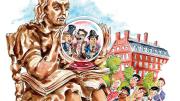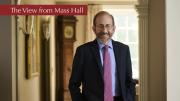As Harvard emerges from a global pandemic that has upset work norms everywhere, it faces its own questions about the kind of workplace it will become. The University took a productive step when, despite initial inclinations, it largely maintained service workers’ pay and benefits as the coronavirus caused its campus to be depopulated, and dining halls and dormitories to close, in the spring of 2020 and into the next academic year. Doing so cost a reported $60 million: a pittance relative to the budget, and the reputational damage Harvard would have incurred from laying off 2,800 employees and contract workers during a crisis—not to mention an unexpected godsend once operations resumed, given difficult hiring conditions now.
Maintaining the service workforce was laudatory, particularly as professional staff members could work from home—or even more idyllic settings. But as “normal” life resumes, how will the University navigate the disparity between those who must work in person and those who have the latitude to fulfill their obligations from afar?
Addressing these issues is a universal conundrum, of course. But residential colleges and universities aren’t just like other places. Most people here maintain that in-person instruction (technologically enhanced, to be sure) trumps all-remote education; that living, studying, and pursuing extracurriculars together advance students’ civic, intellectual, and moral development; and that scholars probing the frontiers of knowledge benefit mightily from direct interactions.
Some staff members have to be proximate to support this activity: dining-hall workers aren’t going to feed the resident population remotely, nor can grounds and facilities personnel run this magnificent campus by drone. These are, of course, the very people who are most exposed to risks of a pandemic (or of traveling to work during blizzards), and who are at the bottom of the University payscale.
Clearly, the people who analyze spreadsheets or review invoices are not similarly constrained. They might well like to work for Harvard, but from a place where housing is cheaper and commuting does not elevate blood pressure. In that light, the arguments seem simple: accommodate remote work, hire great people wherever they may be, and repurpose University offices or shed leases to cut costs.
Not so fast. Given the residential academic mission, and the character of the University’s workforce, there are real, if soft, costs to separating the staff into those able to toil from anywhere and those required to be present. Further privileging those who work in offices compared to those who do not seems likely to divide staff members from one another, unnecessarily.
As for the culture of the place: so long as Harvard remains a residental operation, it ought to want every team member to embrace the mission. Given the choice between, say, a financial analyst who wants to be immersed in the community and one who would rather run Excel from the Exumas, the University ought to perceive the value in the former. That won’t show up in a cell on a spreadsheet (as office costs surely will), but it is a real value nonetheless. Ignore it, and bit by bit the culture of the place will be diminished.
Nor is remote work the only cultural issue concerning the terms of employment to emerge during the pandemic. The Boston Globe reported extensively on the corporate-board service of leaders of area hospitals—many of them Harvard-affiliated teaching institutions. Such cases can pose conflicts (a hospital president and Moderna director profiting from Moderna stock sales as the staff worked on clinical trials of the company’s coronavirus vaccine) that could erode public confidence in the integrity of the research. They also raise conflicts of commitment (the leader of an academic medical center ought to have plenty to do without outside board meetings) and of culture (running a nonprofit institution, for which one receives a seven-figure salary, plus collecting fees for outside board service that easily outstrip the compensation of highly skilled nurses, medical technicians, and others delivering critical coronavirus care—and who face simultaneous salary and benefits freezes). Harvard doesn’t control its affiliates’ governance, but it should hope for better awareness of these concerns—and better examples for its medical students doing their clinical training on the hospitals’ premises.
Like the hospitals, Harvard is a big and complicated place to run—one that provides enough challenges and moments of excitement (wanted and not), one would think, to engage any academic leader. It pays decently for the work: the president earns about $1 million, the provost $750,000, and so on. That’s less than some other higher-education institutions pay, and certainly less than such talents could make in other roles, but plenty for a someone dedicated to the mission of a premier, nonprofit university.
...perhaps the University should now assess the issues of culture and commitment that arise.
As it happens, like the healthcare executives, some senior Harvard leaders have joined corporate boards during the past decade. Given the circumstances, perhaps the University, like the hospitals, should now assess the issues of culture and commitment that arise as a result.
Even assuming that its executives are highly energetic, service on an outside board, faithfully performed, takes time and mental effort, and can understandably be seen as a diversion from the demands of leading Harvard. And within the enterprise, which has taken some commendable steps to be progressive about compensation (charging employees with higher salaries more for health benefits) and to avoid the excesses that have arisen elsewhere, the fees for board service can rankle. During times of financial strain—the fallout from the 2009 crisis, the year after the pandemic began—the University imposed wage freezes on its nonunion workers. At times like that, the six-figure board fees don’t help.
Tending to Harvard’s culture matters as much as caring for its other assets—people, facilities, endowments—to ensure its future. The past two years highlighted some of those strengths, but also vulnerabilities. As leaders of an exceptional place, in all senses of the word, the University’s fiduciaries might proceed gingerly in the months ahead, making sure that Harvard learns the right lessons, and not just the expedient ones, as it emerges from the pandemic justifiably proud of the way it protected community members’ health and sustained the academic enterprise.
—John S. Rosenberg, Editor






